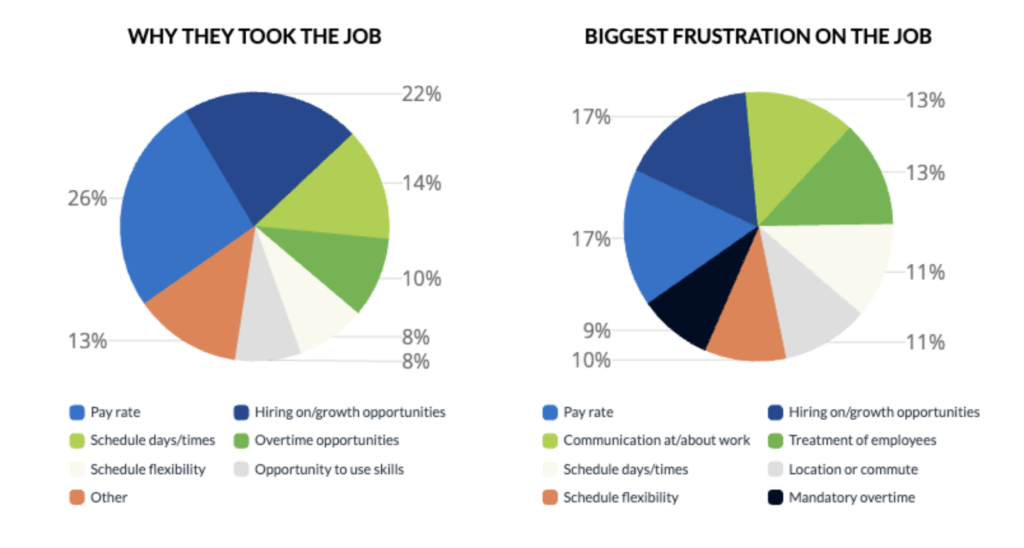Understanding Workforce Satisfaction in Today’s Labor Market
At BelFlex, an Elwood Staffing company, we’re passionate about understanding and enhancing workforce satisfaction. Recently, we conducted a comprehensive survey of over 1,600 working associates across 30 of our clients. Our goal was to learn why they took the job, how they felt about their work environment, the most challenging aspects of their job, areas for improvement, and their satisfaction with training, supervisor support, and their sense of belonging within their companies.
KEY FINDINGS
Why Employees Took the Job
It’s clear that pay is a primary reason associates are attracted to jobs, with over 25% of respondents citing it as their top reason. However, pay is most definitely not the only consideration. Almost half of all respondents stated pay or growth opportunities as top attraction factors, underscoring the importance of providing and promoting clear pathways for career development.
Main Challenges Once on the Job
Once associates are on the job, focus shifts. The next three challenges aside from pay— growth opportunities, treatment of employees, and communication—are almost equally significant. This highlights that while pay and job-specific factors attract employees, interpersonal issues are often what drive them away.

WHAT THIS MEANS FOR EMPLOYERS
Our data clearly shows that while pay and job-specific factors are crucial for attracting talent, interpersonal factors become more important once associates start working. After analyzing each of these frequently cited challenges, it’s vital to then implement strategies to create a supportive and inclusive work environment that is key to retaining employees.
- Too Few Growth Opportunities: Of all respondents, 17% stated working for a company with too few growth and development opportunities is frustrating. Our data also shows that companies that do offer growth opportunities on the job have an exceptional associate NPS (Net Promoter Score®) of 70. Additionally, those who are given the opportunity to use existing skills on the job report an even higher NPS of 80.
- How can you help? Provide clear pathways for advancement and highlight those promotion and development pathways within job posts to attract talent. Implementing job rotations and on the job training programs are other proven ways to foster associate experience, variety and development.
- Poor Treatment of Employees: Associates reporting how they are treated in the workplace as a challenge consequentially report the lowest NPS of 15, which is 22 points lower than any other challenge. Clearly, how they are treated day-to-day has a profound impact on overall job satisfaction.
- How can you help? Create a welcoming atmosphere where associates feel valued and respected. Hosting social/community events, like holiday gatherings and volunteer trips, are great ways to show associate appreciation and keep them engaged. Include temporary workers in meetings where you can, such as company town halls, to make them feel part of the team.
- Lack of Communication: One of the most well-known interpersonal factors, communication, was cited as a challenge for 13% of respondents. Many other challenges can stem from a lack of communication, such as the two listed above. Without communicating properly, how will associates have knowledge of growth opportunities? How will they feel they are being treated?
- How can you help? Maintain open lines of communication to address concerns promptly and keep associates informed. Implementing performance reviews, sharing company or departmental goal progress and hosting events where associates can converse with supervisors and leads are all examples of tactics you can use to facilitate clear communication.
Elwood’s ABC Performance Program is a proven method for reducing turnover. By gathering timely performance feedback through monthly face-to-face updates, the program facilitates early intervention, allows time for improvement, and creates accountability. Implementing such a program can help reduce turnover and enhance employee satisfaction. Reach out to learn more!
Pay and job-specific factors may bring associates in the door, but it’s likely other factors that keep them there. Providing growth opportunities, ensuring fair treatment, and clear communication are crucial for long-term satisfaction and retention.







